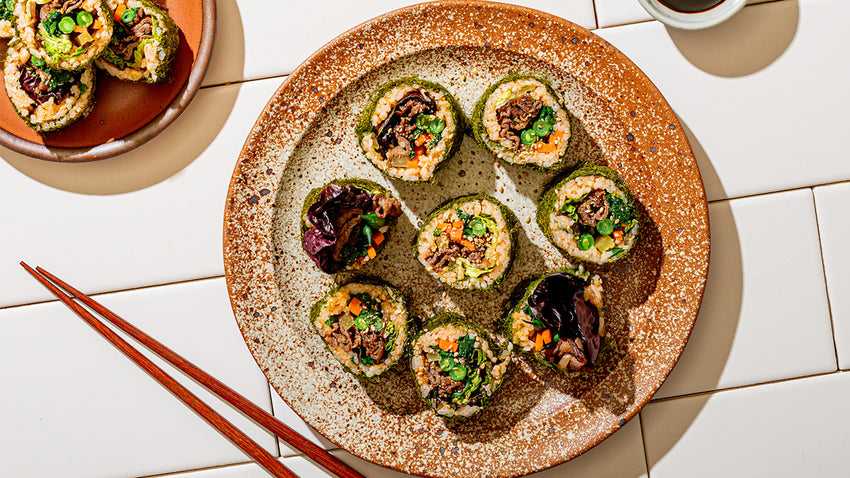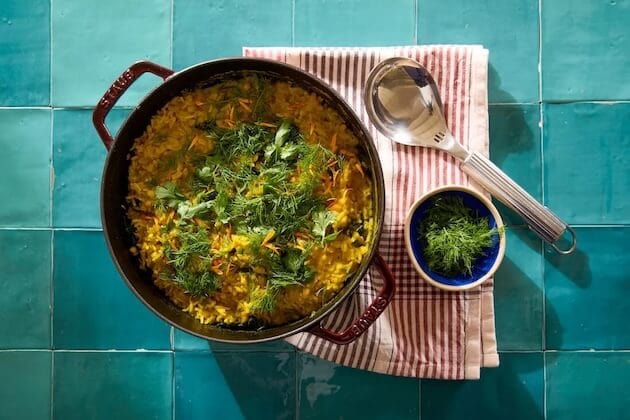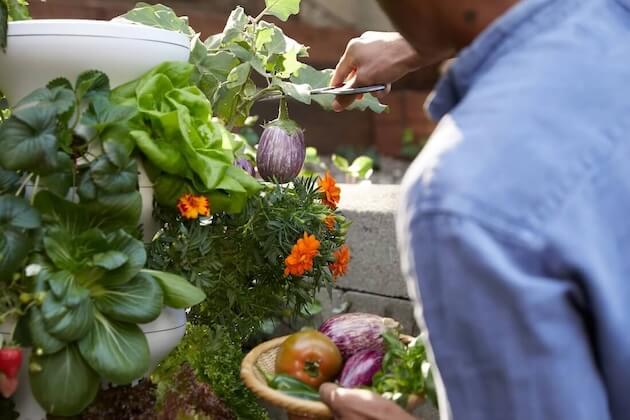Ginger Beef Kimbap with Chili Rice

Don't forget to stop byDiaspora Co.'s shop to stock your pantry with all of the amazing spices used in this recipe!
Ingredients
- 2 Tbsp soy sauce or tamari
- 2 Tbsp light brown sugar
- 1 Tbsp neutral oil, such as canola or rapeseed
- 1 1/2 tsp Mahkir Ginger
- 1/2 tsp freshly ground Aranya black pepper
- 1 large garlic clove, finely grated
- 3/4 pound thinly sliced top sirloin or pre-sliced beef for bulgogi
- 1 large shallot, sliced
- 1 c short grain rice
- 1 tsp Byadgi Chillies
- 2 tsp toasted sesame seeds
- 1 tsp toasted sesame oil
- to taste sea salt
- 1 1/2 tsp canola oil, or neutral oil of your choice
- 1 large bunch spinach, rinsed and patted dry
- 1 tsp toasted sesame oil, plus more for garnish
- 1 tsp toasted sesame seeds, plus more for garnish
- 1 large carrot, cut into matchsticks
- 4 to 6 big leafy lettuce pieces, ribs removed
- 1 green beans, cut into long strips (can also use Persian cucumbers)
- 1/2 Korean pickled yellow radish, cut into long strips
- 4 large pieces gim (seaweed paper)
- for dipping soy sauce or tamari
Instructions
*Chef’s note: You can buy sliced beef for bulgogi at your local Korean market, or you can also find thinly sliced beef for shabu-shabu at Japanese markets as well. Alternatively, you can slice the meat yourself: First, freeze the piece of top sirloin for 15 to 20 minutes, then thinly slice, against the grain with a sharp knife.
Step 1
To make the marinade for the beef, place the soy sauce, sugar, oil, ginger, black pepper, and garlic in a medium bowl and whisk together until the sugar dissolves. Add the beef and toss to coat every piece in the marinade. Cover and refrigerate for 30 minutes, up to 8 hours.
Step 2
To make the rice, place the rice in a medium bowl, cover with cold water, gently swishing the rice with your fingers, and drain. Repeat the process until the water runs clear. Transfer the drained rice to a medium saucepan, add the Byadgi chillies and 1¾ cups water, and stir to combine. Cover, bring to a boil over medium high heat, reduce the heat to low, and cook until the rice is tender and cooked through, about 15 minutes. Turn off the heat and let stand, covered, for 5 minutes. Alternatively, you can cook the chili rice in a rice cooker.
Step 3
Add the sesame seeds, sesame oil, and salt to the chili rice, stir to combine, and set aside.
Step 4
While the rice is cooking, prepare the cooked vegetable fillings and bulgogi. To make the spinach, heat the canola oil in a large skillet over medium high heat. Add the spinach and cook, stirring occasionally, until wilted, tender, and any water has evaporated, about 2 to 4 minutes. Transfer the spinach to a small bowl and let it cool for 5 minutes. If the spinach still looks watery, gently squeeze out any excess liquid and return to the bowl. Add the sesame oil, sesame seeds, season with salt, to taste, and set aside.
Step 5
Return the same skillet over medium high heat, add the carrots, and cook until they just start to become pliable, but still retain an al dente bite, about 1 to 2 minutes. Transfer to a small bowl, season with salt, to taste, and set aside. Reserve skillet for later use.
Step 6
Return the skillet to high heat and heat until the pan is almost smoking. Add the marinated meat and shallots, spreading them into a single layer, and cook undisturbed until the meat starts to brown and caramelize, about 4 minutes. Stir and continue to cook until the meat is cooked through, about another 4 minutes. Turn heat off and leave the meat in the skillet.
Step 7
To assemble the kimbap, place a piece of gim shiny side down on a bamboo rolling mat. Take ¼ of the rice and spread it in a thin, even layer over the gim, leaving a 1½-inch strip at the top. Arrange your vegetables and meat across the lower part of the rice-covered gim, leaving ½-inch strip uncovered at the bottom. Start with some lettuce, then some bulgogi, sesame spinach, a few strips of pickled radish and green beans (or cucumbers), and finishing with some carrots.
Step 8
Lightly wet the naked part of the gim with your fingers, then gently roll the bamboo mat up and away from you, using your fingers to keep the filling in place, so the rice and gim start to wrap around the fillings. Pushing the mat as you roll, continue to roll until roll is fully sealed. Grab the mat with both hands, pulling back slightly and then squeezing to tighten the center and ends of the roll. Set the finished roll aside and repeat with the remaining gim, rice, and fillings.
Step 9
Brush the tops of the finished kimbap with a little extra sesame oil and sprinkle with sesame seeds, then using a sharp knife, cut each roll into 6 to 8 pieces. (It helps to wipe down the knife between every few slices to maintain a beautiful, clean midsection.)
Step 10
Arrange the sliced kimbap on a platter, sprinkle with a few more sesame seeds, if desired, and serve with soy sauce for dipping.





















